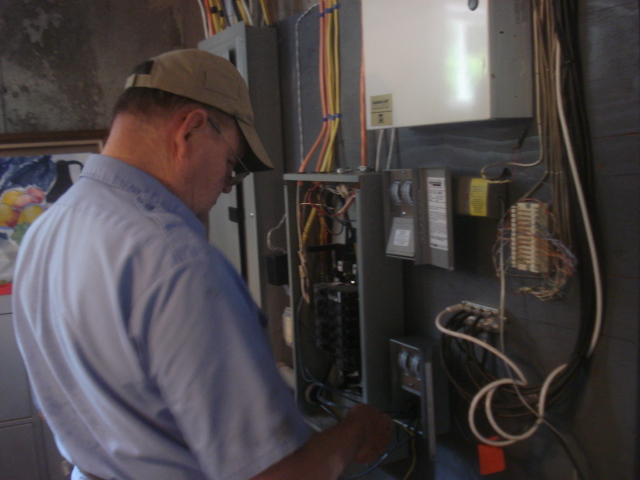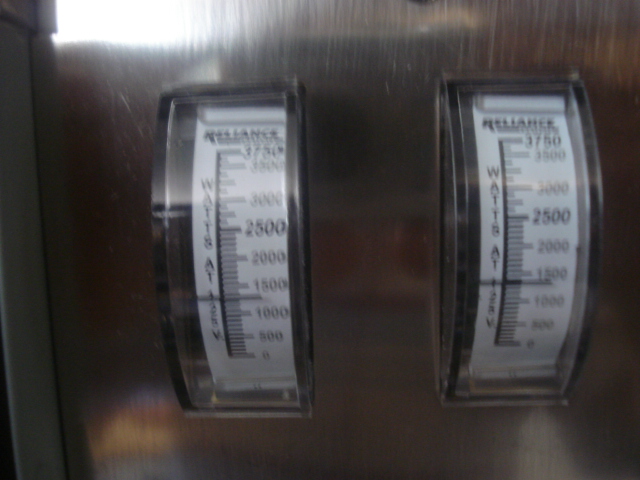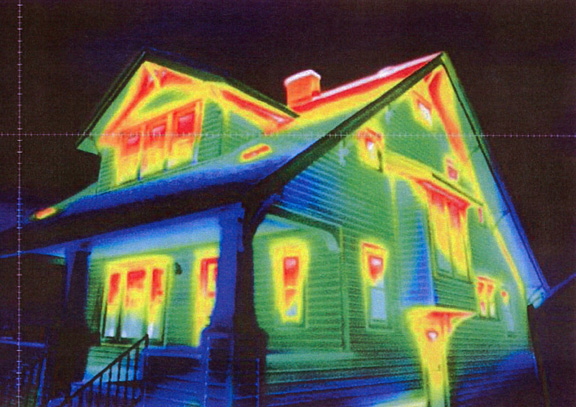Yes. You can substitute all or portions of your system with ground heat or cooling. For existing homes, you may leave old components in place or remove them. Right now, using the existing air handler and duct system is best. For homes with baseboard hot water heat, it might be necessary to run some ducts. I have left my oil burner hooked up, so that if we get a week of zero temperatures that strains my geothermal capacity, the computer automatically switches to fuel oil heat until the geothermal system is ready again. A new home system I am designing will have a propane backup system, but Caren and Bob's horizontal loop system has worked great for 25 years without backup.
No. There are no licensing requirements in Connecticut or New York for the horizontal loop. Where deep soils and acreage are limited, you might choose the more expensive drilled geothermal wells that must be drilled by licensed well drillers. The advantage of an engineered drawing is that the autocad program used to design the site plans on this web site can accurately determine pipe lengths for ordering and sizing purposes.
You need a wetlands permit if you are digging within the upland review area (100' from a watercourse or wetland in Litchfield) We do not recommend installing horizontal loops in wetlands at this time, except for deep ponds on your own property. The policy now is that you must send in your application and get on the next monthly meeting agenda, even if working only under an existing lawn near a wetland or watercourse. There have been no adverse impacts associated with wetlands, as long as prudent erosion controls are implemented. Always specify silt fence to protect sediment from entering wetlands until grass seed is germinated. A good rule of thumb is to keep all trenching at least 10' away from wetlands so that the excavator need not go near wetlands. Do not change groundwater flow in the trench that would affect a nearby wetland.
Send to the health dept to show it is not near a septic system. (10' to Primary)
For inside heating and air conditioning work, you need a licensed HVAC person. There are some provisions for the do it yourselfer. But you must do the work yourself in a home in which you reside. Check with the Dept. of Consumer Protection at www.ct.gov/dcp
You should - first by making a visual observation of your yard and then by reviewing your survey and your septic system As Built plans on file in the Torrington Area Health District.
CBYD = Call Before You Dig in Connecticut 800-922-4455 must be called a few days before you start. They can locate your main underground power, but they do not locate all utilities, such as sprinkler systems or even electric outdoor lighting. 4" diameter footing drains if cut, can be spliced, but should normally be on a straight line from the outfall to the corner where they leave the house.
The Health Code requires a 10' separation from a primary septic system. Send Torrington Area Health District the plans to be sure you comply.
There should be no surprises for the backhoe/ ditch witch operator. Everything should be clearly spray painted before the start. It is the homeowners responsibility to map out everything that will be encountered underground. Test holes by shovel or machine might be required. If you are not certain, do not dig.
High ledge is not good. If the trench cannot be 4' deep or deeper, you will loose electricity efficiency because the ground will not be warm in the winter. But short runs where the pipe is only 2' or 3 ' deep do not loose that much efficiency, and are not a reason to terminate the project.
Groundwater is a better conductor than air between soil particles. So builders will be surprised that good dry sandy soils for foundations and septic systems are less desirable than mottled hardpan with high groundwater that is good for geothermal systems.
Note: I recently learned that high ledge is being used in New York State where contractors are using track drills to drill 70' deep angled holes about 2" in diameter. They are installing copper geo pipe, in areas of limited acreage or access to a well drilling rig. But in Connecticut, this might be considered unlicensed drilling.
Here's what a track drill looks like:

We are also looking into farm style trenchers:
http://www.northlandtrenching.com/index.html

What if I encounter a buried stump?
DEP allows burial of stumps that came from the same property as long as the burial hole does not exceed 10 cubic yards. If the backhoe encounters a stump, rebury it nearby, or dispose of it at Supreme Industries. stumps should not be buried near septic systems or driveways where decomposed settlement could be a problem.
No. In the summer, the outlet pipe from your house might rise in temperature like mine this week. Outdoor temps were up to 95 degrees as you recall if you ran the Litchfield Hills Road Race like I did. My inlet pipe water temperature was up to 65 degrees, and the outlet temperature was as high as 93 degrees. After the 730 feet through the pipe temperature was back at 65 or 66 degrees. The pipe easily withstands this heat, and since there are no roots near the pipes, no vegetation is affected. rodents would no sooner nibble on this warm pipe than they would on your water well pipe line from your well to your house.
In the winter, soil immediately surrounding the geo pipe could freeze near the house if it is put out at say 20 degrees. Again roots and animals would not be affected. Grass 6' above should not be affected. As Irma Bombeck use to write -The grass is always greener over the septic tank :}
There have not been reports of moles or mice eating through water well line polyethylene, so the thicker geo pipe should not be something that attracts them either. HDPE means high density polyethylene pipe. The black geo pipe density appears to meet this definition. For pond loops where beavers might gnaw on underwater loops, add a protective screen or encase the geo pipe in a perforated sleeve pipe.
Yes. See one of the designs that does not cross electric lines, etc. Use a manifold inside to connect to one heat pump or use two heat pumps.
If the loop breaks, the heat pump will react as pressure falls to zero. Gages are attached to the outside of the heat pump. At that point, the line should be dug up at mid section and air tested until the break is located. Then heat fuse a repair line. But this has never been reported to have happened, and the pipe does have a 50 year lifetime warranty. For areas where outside connections are necessary, provide manhole type portal boxes for future access.
Remember that the only spillage in a worse case scenario would be water with a propylene glycol (food based) 17% solution that would not harm anything.
No. The geo pipe is completely filled with water and biodegradable antifreeze. Frictional head loss is only a function of internal pipe resistance, not head water depth. So no topography info is needed. Note that this means that well systems and horizontal loop systems can use the same flow controller circulating pump.
The lengths within deep drilled wells and the geo pipe soil or bentonite contact are figured into the rule of thumb trench length or well depth calculations that can also be determined by various computer programs.
Allow two weeks. So if no wetlands meeting is required, and you know the exact length, plan on digging in two weeks. And Call Before You Dig one week in advance.
All those googled web links give rules of thumb like 200' to 300' per ton depending on soils and pipe volumes.
After struggling with the heavy 2" diameter pipe, I am an advocate for 1 1/2" pipe. But choices must be made depending on amount of soil that can be utilized, type of excavating equipment available, laborers that cannot enter deep trenches, etc. Some web sites warn against putting too much pipe into too little a trench length, so I do not favor the slinky coil method, but okay where soil resources are limited. Try to get the most out of the soil with enough pipe that is not excessively long for your wall mounted circulating pump.
Remember we are only drawing out enough heat to help a single family dwelling here. For geothermal heating of industrial or large facilities, or for electric power generation, you need several deep wells or a "Geo thermal hot spring" as found elsewhere in the USA.
The purpose of your geothermal system is to save energy and money. Over sizing can make the system so expensive that a decision is made not to go forward. We need not have a Cadillac system to anticipate the rare peak needs. On very cold days, simply plug in an electric space heater, or feed the fireplace.
Is it worth it to spend an extra $5000 in unneeded loop pipe so that you save $5.00 or $10.00 on your CL&P bill occasionally? No.
I think it is noble to share information rather than to try and profit from it, at people's expense. I was able to get free information thanks to Google, and I feel that my 30 years of professional engineering experience in soils and water allow me to make some reasonable recommendations. Do I accept liability for any of this? No. But I can help you if you need it, and I can rest easy knowing that the American spirit for energy independence is alive and well thanks to web sites like this, and energy pioneers who are willing to install a horizontal loop system.
Pete
Please email me your further questions for posting with or without your name. PeterJTJ@aol.com
I have been taking on a few selected clients who reimburse me for my time, but this web site encourages the Do it yourselfer, not the paying client.


